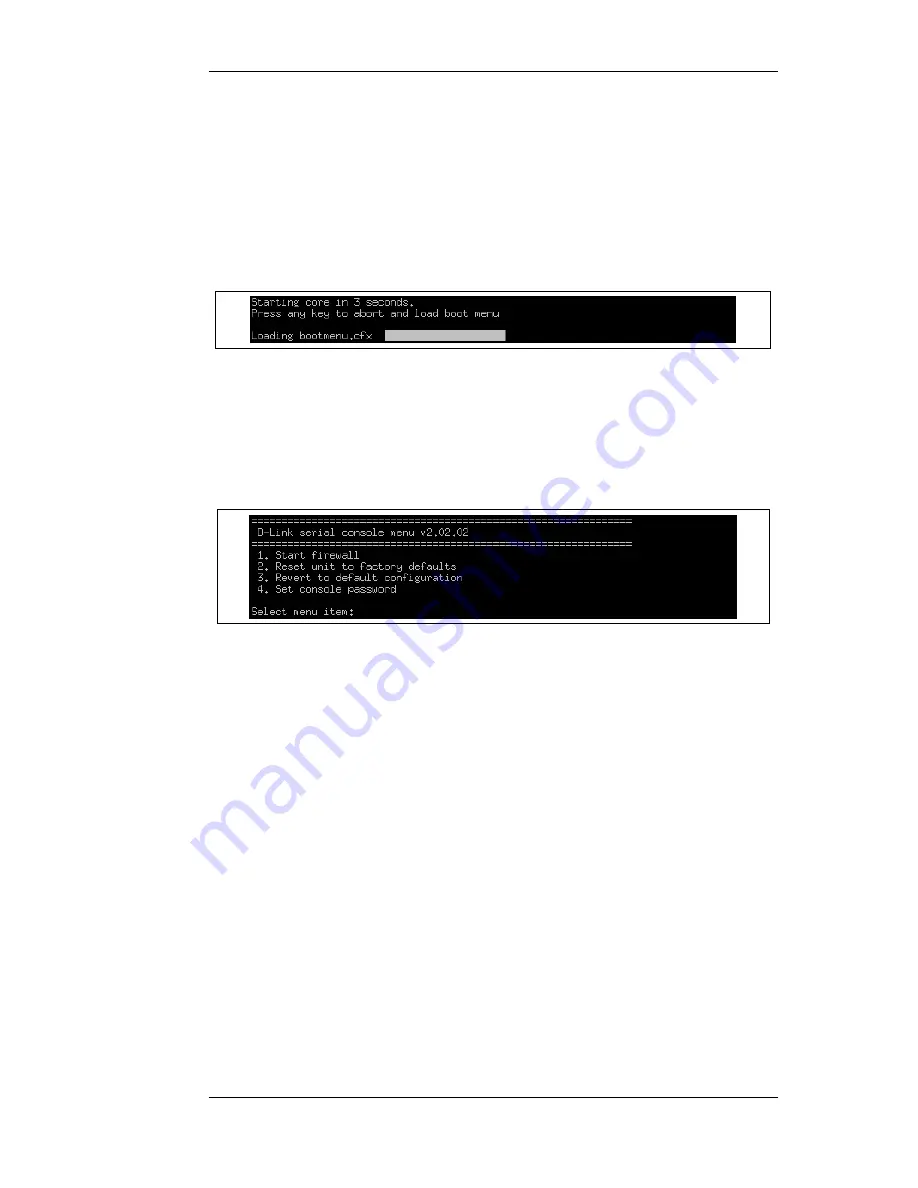
Accessing the Console Boot Menu
The boot menu is only accessible through a console device attached directly to the serial console
located on the NetDefend Firewall. It can be accessed through the console after the NetDefend
Firewall is powered up and before NetDefendOS is fully started.
After powering up the NetDefend Firewall, there is a 3 second interval before NetDefendOS starts
up and in that time the message Press any key to abort and load boot menu is displayed as shown
below:
If any console key is pressed during these 3 seconds then NetDefendOS startup pauses and the
console boot menu is displayed.
Initial Boot Menu Options without a Password Set
When NetDefendOS is started for the first time with no console password set for console access
then the full set of boot menu options are displayed as shown below:
The options available in the boot menu are:
1.
Start firewall
This initiates the complete startup of the NetDefendOS software on the NetDefend Firewall.
2.
Reset unit to factory defaults
This option will restore the hardware to its initial factory state. The operations performed if this
option is selected are the following:
•
Remove console security so there is no console password.
•
Restore default NetDefendOS executables along with the default configuration.
3.
Revert to default configuration
This will only reset the configuration to be the original, default NetDefendOS configuration
file. Other options, such as console security, will not be affected.
4.
Set console password
Set a password for console access. Until a password is set, anyone can utilize the console so
selecting setting the password as soon as possible is recommended. After it is set, the console
will prompt for the password before access is allowed to either the boot menu or the command
line interface (CLI).
2.1.7. The Console Boot Menu
Chapter 2. Management and Maintenance
49
Summary of Contents for NetDefend DFL-260E
Page 27: ...1 3 NetDefendOS State Engine Packet Flow Chapter 1 NetDefendOS Overview 27...
Page 79: ...2 7 3 Restore to Factory Defaults Chapter 2 Management and Maintenance 79...
Page 146: ...3 9 DNS Chapter 3 Fundamentals 146...
Page 227: ...4 7 5 Advanced Settings for Transparent Mode Chapter 4 Routing 227...
Page 241: ...5 4 IP Pools Chapter 5 DHCP Services 241...
Page 339: ...6 7 Blacklisting Hosts and Networks Chapter 6 Security Mechanisms 339...
Page 360: ...7 4 7 SAT and FwdFast Rules Chapter 7 Address Translation 360...
Page 382: ...8 3 Customizing HTML Pages Chapter 8 User Authentication 382...
Page 386: ...The TLS ALG 9 1 5 The TLS Alternative for VPN Chapter 9 VPN 386...
Page 439: ...Figure 9 3 PPTP Client Usage 9 5 4 PPTP L2TP Clients Chapter 9 VPN 439...
Page 450: ...9 7 6 Specific Symptoms Chapter 9 VPN 450...
Page 488: ...10 4 6 Setting Up SLB_SAT Rules Chapter 10 Traffic Management 488...
Page 503: ...11 6 HA Advanced Settings Chapter 11 High Availability 503...
Page 510: ...12 3 5 Limitations Chapter 12 ZoneDefense 510...
Page 533: ...13 9 Miscellaneous Settings Chapter 13 Advanced Settings 533...














































